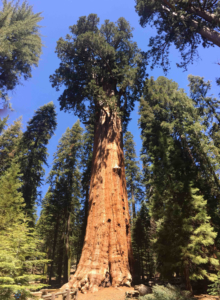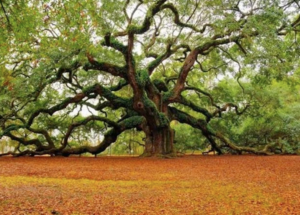*We all need Nature. Nature provides us with powerful, free medicine that maintains our health and wellbeing especially in this man-made toxic 21st century.
Big, old trees are crucial as superlative carbon dioxide warehouses that also absorb mega amounts of pollution. Big trees regulate the climate, the water cycle, and provide priceless shade in the heat of the summertime as well as create vital habitat for creatures.
As the ancient ones age they increase, not decrease, in their ability to perform as Nature’s giant oxygen generators and carbon warehouses.

Photo credit: Reese Halter, Sequoia National Park.
Researchers at Nippon Medical School in Tokyo discovered that hiking and relaxing in the forest air for three days at a time boosted human natural killer immune cells, or NK cells, which protect against diseases activated by stress-induced cortisol within white blood cells.
Not only does ancient forest air melt away stress, but also it jacks-up NK cells by up to 40 percent, which fight both infections and cancers.

Photo credit: Reese Halter, Styx Valley, Tasmania.
For those who could not get to a heavenly ancient forest to breathe its salubrious air, my colleagues found that a one-hour walk in a city park lined with big trees also boosted NK cells, but not quite as much as a wild or ancient forest.
So exactly what’s elevating human NK cells within ancient forests or even a tree-lined city park?
Trees release many aromatic volatile compounds from leaves and even bark. These compounds have been christened phytoncides.
Trees and plants manufacture these complex chemicals as a protective measure against insects, germs, and as I described in detail in my book, The Insatiable Bark Beetle, to communicate above ground with other trees.

Photo credit: uncletreeshouse.com
These aromatic volatile substances include terpenes, pinenes, limones, and others. As air temperature rises, it causes biochemical reactions in wood, leaves, and bark. By midsummer, forests are spicy. Trees’ defense mechanisms are heightened to counter possible insect infestations.
Pinosylvin is within the heartwood of pines, spruce, firs, and Douglas-firs. It protects the trees against fungal infections as well as traumatic injuries.
Terpenoids in yews, cypress, cedars, eucalypts, and junipers act as a mild sedative, which repels both insects and herbivores. Both pinosylvins and terpenoids are known as relaxants for people, too.
Forests contain hundreds and possibly thousands of these incredible scents. When the human nose encounters them, it activates our auto-immune system.
It’s like walking into Nature’s fragrant medicine chest and all that’s required is to breathe deeply. How great is that!
Take 15 minutes each day, disconnect from all electronics and clear your mind while you stand next to a big, old tree and breathe all the way to the bottom of your lungs then exhale and repeat. Allow 400 million years of Nature’s exquisite wellness tree science to permeate and recharge as many as 40 trillion cells in your body.
#Resist
•••••••••••••••••••••••••••••••••••••••••••••
Dr Reese Halter is an award-winning broadcaster, distinguished conservation biologist and author.
Dr Reese Halter’s latest book is
Save Nature Now
Tweet @RelentlessReese









